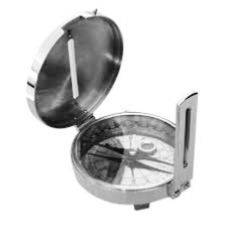Table of Contents
What Is Compass Surveying?
Compass surveying is a particular type of survey which is used to locate an object by linear measurements and angular measurements. Magnetic compass is used to measure angles, while chain or tape is used to measure lengths.

Compass surveying employs the concept of traversing. Traverse lines are made with the use of a compass. The compass determines a line’s bearing in relation to the magnetic needle. The included angles can then be determined using the appropriate formulas for both a clockwise and an anticlockwise traversal.
Surveyors take two bearings, a fore bearing and a back bearing, for each survey line in the traverse. If the local attraction is minimal, these bearings should precisely differ by 180°.
Working Principle Of Compass Survey
Compass survey is carry out by using traversing concept. A network of lines connects the survey points. The compass instrument’s magnetic bearing is used to measure it. The chain measures the length, while the angle between the lines measures the distance. The term compass navigating describes it.
Mistakes In Compass Survey
During the surveying process, errors can occur for a variety of reasons. They are divided into the following categories:
1. Inadvertent mistake
As their name implies, they result from incorrect instrument adjustments. Other factors include:
Errors in sighting and reading result from a non-vertical plane of sight.
Readings might not be accurate if the magnetic needle is not completely straight or if it moves slowly.
2. Personal Mistake
They develop primarily as a result of the surveyor’s negligence. As follows:
- Improper leveling
- Erroneous reading
- Incorrect centeredness
3. Natural Mistakes
Natural blunders happen as a result of the different natural factors that have an impact on how a compass functions. To downplay them and say it has nothing to do with the surveyor,
Advantages Of Compass Surveying
- They are lightweight and can be transported easily.
- Fewer settings are available to fix it on a station.
- One survey line’s direction inaccuracy has no bearing on the other lines.
- It is appropriate to retrace previous surveys.
Disadvantages Of Compass Surveying
- It is less accurate than other cutting-edge surveying techniques.
- It is susceptible to a number of inaccuracies, including errors next to magnetic meridian, local attraction, etc.
- Error can also result from improper leveling and poor range rod sighting.
